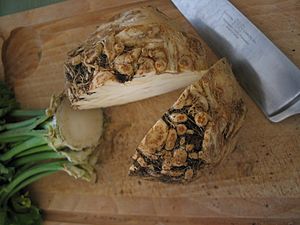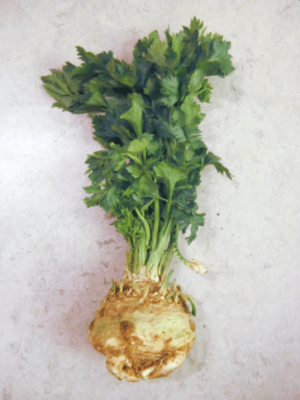Celeriac facts for kids
Quick facts for kids Celeriac |
|
|---|---|

A celeriac hypocotyl sliced in half, and with the greens removed
|
|
| Genus | Apium |
| Species | Apium graveolens |
| Cultivar group | Celeriac Group |
| Cultivar group members |
|
Celeriac (which is also known as Apium graveolens var. rapaceum) is a cool vegetable! People also call it celery root, knob celery, or turnip-rooted celery. Even though it has "turnip" in its name, it's not actually a close relative of the turnip.
Celeriac is a special type of celery. It's grown because its stem, which is called a hypocotyl, and its shoots are good to eat. Think of it like a root vegetable, but it's actually a big, round stem that grows underground. It has lots of small roots attached to it.
You can find celeriac growing in many places around the world. It's very popular in countries near the Mediterranean Sea and in Northern Europe. It's also grown in North Africa, Siberia, Western Asia, and North America. In North America, a type called 'Diamant' is the most common.
History of Celeriac
Celeriac and regular celery both started growing in the Mediterranean area a very long time ago. They were even mentioned in famous ancient Greek stories like the Iliad and the Odyssey. In those stories, it was called selinon.
Long ago, some early civilizations used celeriac as a plant for medicine. Celery has a natural plant chemical called apigenin. This chemical was used in traditional Chinese medicine to help with swelling and inflammation.
Cooking with Celeriac
Usually, celeriac is picked when its round stem is about 10 to 14 centimeters (4 to 5.5 inches) wide. But some chefs, especially in places like Peru, like to use it when it's younger. The younger celeriac is known for having a stronger flavor and being more tender.
You can eat celeriac raw or cooked. It tastes a lot like the green stalks of regular celery. You can roast it, stew it, or boil it until it's soft, then mash it up. Thin slices of celeriac are often added to soups, casseroles, and other tasty dishes.
The leaves and stalks of the celeriac plant are also very flavorful. They look pretty and bright, so chefs sometimes use them as a garnish to make fancy meals look even better.
Celeriac can stay fresh for about six to eight months if you store it in a cool place (between 0 and 5 degrees Celsius or 32 and 41 degrees Fahrenheit) and don't let it dry out. However, if the small stems around the bottom are left on, the celeriac might start to rot in the middle. Sometimes, even fresh celeriac can have a small hollow spot in the center. You can also tell how fresh it is by its taste: the older it gets, the weaker its celery flavor will be.
|
||||||||||||||||||||||||||||||||||||||||||||||||||||||||||||||||||||
See also
 In Spanish: Apio para niños
In Spanish: Apio para niños


